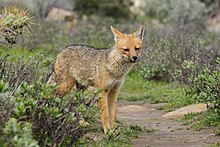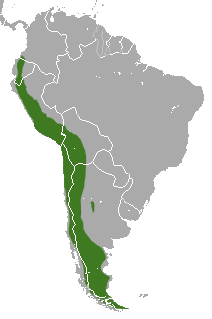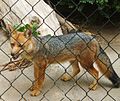Culpeo
| Culpeo | |
|---|---|

| |
| Culpeo in Peru | |
| Scientific classification | |
| Domain: | Eukaryota |
| Kingdom: | Animalia |
| Phylum: | Chordata |
| Class: | Mammalia |
| Order: | Carnivora |
| Family: | Canidae |
| Genus: | Lycalopex |
| Species: | L. culpaeus
|
| Binomial name | |
| Lycalopex culpaeus (Molina, 1782)
| |

| |
| Culpeo range | |
The culpeo (Lycalopex culpaeus), also known as Culpeo zorro, Andean zorro, Andean fox, Paramo wolf,[3] Andean wolf,[4] and colpeo fox,[4] is a species of South American fox. Despite the name, it is not a true fox, but more closely related to wolves and jackals. Its appearance resembles that of foxes due to convergent evolution.
The culpeo's diet consists largely of rodents, rabbits, birds and lizards, and to a lesser extent, plant material and carrion. They may prey on Andean flamingos and baby vicuña. The culpeo occasionally attacks sheep and is, therefore, often hunted or poisoned.[5] In some regions, it has become rare, but overall the species is not threatened with extinction.
The culpeo was domesticated by the Selk'nam people of Tierra del Fuego, producing the Fuegian dog which became extinct in the late 19th or early 20th century.[6]
Description
[edit]
The culpeo is a canid intermediate in size between a red fox and a coyote. It is the second-largest native canid on the continent after the maned wolf. In appearance, it bears many similarities to the widely recognized red fox. It has grey and reddish fur, a white chin, reddish legs and a stripe on its back that may be barely visible. The average weight of the male is 11.4 kg (25 lb), while the typically smaller females average 8.4 kg (19 lb). Overall, a weight range of 5 to 13.5 kg (11 to 30 lb) has been reported. Total length can range from 94 to 133 cm (37 to 52 in), including a tail of 32 to 44 cm (13 to 17 in) in length.[7] The pelt has a grizzled appearance. The neck and shoulders are often tawny to rufous in color, while the upper back is dark. The bushy tail has a black tip.[8]
Range
[edit]
The culpeo's range extends from the southern regions of Patagonia and Tierra del Fuego in the south to Ecuador and Peru in the north, with some populations extending into southern Colombia. It is also found in the Sierras Grandes mountain range in Córdoba, Argentina.[9] It is most common on the western slopes of the Andes, where it inhabits open country and deciduous forests.
Habitat
[edit]The culpeo lives in a wide variety of habitats of western South America. They are found in broadleaf Nothofagus temperate rainforest, sclerophyllous matorral, deserts, chaparrals, and plateaus, like the Altiplano, up to the tree line (4,800 metres (15,700 ft)).[1]
Diet
[edit]
The culpeo is an opportunistic predator that will take any variety of prey. It mainly feeds on rodents (including common degus) and lagomorphs (especially the introduced European rabbit and European hare); however, it occasionally feeds on domestic livestock and young guanacos.[10][11] They will also feed on insects, birds, lizards, fruit, and carrion of llamas and vicuñas.[11] Culpeos are considered beneficial because they are significant predators of the rabbits introduced in 1915; such introduced rabbit populations are believed to have allowed culpeos to spread from the Andean foothills across the Patagonian plain.[12] They sometimes take young lambs up to 1 week old. In limited studies, the larger culpeo appears to dominate potential competitors, including South American gray foxes, Geoffroy's cats, pampas cats, grisons and various raptorial birds.[8] In the southeastern Argentine Patagonia region, culpeos generally tend to consume more of the introduced European hare than the South American gray fox does year-round, while the gray fox tends to consume more rodents. However, during colder seasons, the culpeo's diet overlaps more with the gray fox due to a lack of variety in prey, thus causing prey partitioning as the culpeos use their size advantage to exclude the gray fox from areas with higher concentrations of prey.[13] Its range also overlaps that of the much larger puma, but the size difference ensures that the two species have limited competition. They are known to eat the carcasses of vicuñas. Culpeos have also been observed preying upon introduced beavers in Tierra del Fuego.[14] During a period of drought in central Chile's scrublands lagomorphs, coati, goats, and cattle make up a large amount of their diet.[15]
Reproduction
[edit]The typical mating period is between August and October. After a gestation period of 55–60 days, the female gives birth usually to between two and five pups.
Classification
[edit]Subspecies
[edit]-
Lycalopex culpaeus andinus (Thomas, 1914)
-
Lycalopex culpaeus culpaeus (Molina, 1782)
-
Lycalopex culpaeus lycoides (Philippi, 1896)
-
Lycalopex culpaeus magellanicus (Gray, 1837)
-
Lycalopex culpaeus reissii (Hilzheimer, 1906)
Taxonomy
[edit]The taxonomy of the culpeo has been the topic of debate due to their high phenetic variability and the scarcity of research, among other things. Over the past three decades, they have been placed variably in the genera Dusicyon (Clutton-Brock, et al., 1976; Wozencraft, 1989), Canis (Langguth, 1975; Van Gelder, 1978), Pseudalopex (Berta, 1987; Wozencraft, 1993; Tedford et al., 1995) and Lycalopex (Zunino, 1995; Wozencraft, 2005).[16]
This canid, like other South American foxes, is still sometimes classified as a member of the genus Pseudalopex.[1] As Pseudalopex and Lycalopex have largely come to describe the same genus, either classification is acceptable, although the modern practice is to give Lycalopex prominence.[17]
References
[edit]- ^ a b c Lucherini, M. (2016). "Lycalopex culpaeus". IUCN Red List of Threatened Species. 2016: e.T6929A85324366. doi:10.2305/IUCN.UK.2016-1.RLTS.T6929A85324366.en. Retrieved 12 November 2021.
- ^ "Appendices | CITES". cites.org. Retrieved 2022-01-14.
- ^ Guntiñas, Marta; Lozano, Jorge; Cisneros, Rodrigo; Llorente, Esther; Malo, Aurelio F. (2021). "Ecology of the culpeo (Lycalopex culpaeus): a synthesis of existing knowledge". Hystrix: The Italian Journal of Mammalogy. 32 (1): 5–17. doi:10.4404/hystrix-00388-2020.
- ^ a b Comparative ecology of two South American foxes, 'Dusicvon ariseus' and 'Culpaeus' by Warren E. Johnson. Doctoral dissertation. Iowa State University; 1992. p2. Accessed July 10, 2021 at https://lib.dr.iastate.edu/cgi/viewcontent.cgi?article=11006&context=rtd
- ^ Macdonald, David Whyte; Claudio Sillero-Zubiri (2004). The Biology and Conservation of Wild Canids. Oxford University Press. ISBN 978-0-19-851555-5.
- ^ Petrigh, Romina S.; Fugassa, Martin H. (December 13, 2013). "Molecular identification of a Fuegian dog belonging to the Fagnano Regional Museum ethnographic collection, Tierra del Fuego" (PDF). Quaternary International. 317: 14–18. Bibcode:2013QuInt.317...14P. doi:10.1016/j.quaint.2013.07.030. Archived from the original (PDF) on December 20, 2016. Retrieved September 2, 2020.
- ^ Burnie D and Wilson DE (Eds.) (2005), Animal: The Definitive Visual Guide to the World's Wildlife. DK Adult, ISBN 0789477645. p. 182
- ^ a b Andrés J. Novaro (24 October 1997). "Pseudalopex culpaeus" (PDF). Mammalian Species (558). American Society of Mammalogists: 1–8. doi:10.2307/3504483. JSTOR 3504483. Archived from the original (PDF) on 2013-05-14 – via www.science.smith.edu.
- ^ "Zorro Colorado" (PDF). Ministerio de Ambiente y Desarollo Sustentable de Argentina (in Spanish). Retrieved 6 Jan 2023.
- ^ Novaro, Andres J.; Moraga, Claudio A.; Briceño, Cristobal; Funes, Martin C.; Marino, Andrea (2009). "First records of culpeo (Lycalopex culpaeus) attacks and cooperative defense by guanacos (Lama guanicoe)". Mammalia. 73 (2): 148–150. doi:10.1515/MAMM.2009.016. hdl:11336/102311. S2CID 84525738.
- ^ a b "Lycalopex culpaeus (Culpeo)". Animal Diversity Web.
- ^ Alderton, David. Foxes, Wolves, and Wild Dogs of the World. London: Blandford, 1998. p175-6.
- ^ Zapata, Sonia C.; Travaini, Alejandro; Delibes, Miguel; Martínez-Peck, Rolando (August 2005). "Food habits and resource partitioning between grey and culpeo foxes in southeastern Argentine Patagonia". Studies on Neotropical Fauna and Environment. 40 (2): 97–103. doi:10.1080/01650520500129836. hdl:10261/50241. ISSN 0165-0521.
- ^ Tadich, Tamara A.; Novaro, Andrés J.; Kunzle, Pablo; Chacón, Mauricio; Barrientos, Miguel; Briceño, Cristóbal (2017-11-03). "Agonistic behavior between introduced beaver (Castor canadensis) and endemic culpeo fox (Pseudalopex culpaeus lycoides) in Tierra del Fuego Island and implications". Acta Ethologica. 21 (1). ISPA CRL Portuguese Ethological Society (Springer): 29–34. doi:10.1007/s10211-017-0278-z. hdl:11336/95336. ISSN 0873-9749. S2CID 11176126.
- ^ molina 1782
- ^ Jiménez, J.E.; Novaro, A.J. (2004). "Chapter 3.4: Culpeo (Pseudalopex culpaeus)". In Sillero-Zubiri, C.; Hoffmann, M.; Macdonald, D.W. (eds.). Canids: Foxes, Wolves, Jackals, and Dogs. Archived from the original (PDF) on 2011-10-06. Retrieved 2012-05-08.
- ^ Wozencraft, W. C. (2005). "Order Carnivora". In Wilson, D. E.; Reeder, D. M. (eds.). Mammal Species of the World: A Taxonomic and Geographic Reference (3rd ed.). Johns Hopkins University Press. pp. 579–581. ISBN 978-0-8018-8221-0. OCLC 62265494.
- ^ Lindblad-Toh, K.; Wade, C.M.; Mikkelsen, T.S.; Karlsson, E.K.; Jaffe, D.B.; Kamal, M.; Clamp, M.; Chang, J.L.; Kulbokas 3rd, E.J. (2005). "Genome sequence, comparative analysis and haplotype structure of the domestic dog" (PDF). Nature. 438 (7069): 803–819. Bibcode:2005Natur.438..803L. doi:10.1038/nature04338. PMID 16341006. S2CID 4338513.
{{cite journal}}: CS1 maint: numeric names: authors list (link) - ^ Wang, X.; Tedford, R.H. (2007). "Ch1-Evolutionary History of Canids". In Jensen, Per (ed.). The Behavioural Biology of Dogs (1 ed.). Cabi Publishing. p. 11. ISBN 978-1845931872.
- IUCN Red List least concern species
- South American foxes
- Mammals of the Andes
- Mammals of Patagonia
- Mammals of Argentina
- Mammals of Bolivia
- Mammals of Chile
- Mammals of Colombia
- Mammals of Ecuador
- Mammals of Peru
- Fauna of Tierra del Fuego
- Fauna of the Falkland Islands
- Carnivorans of South America
- Mammals described in 1782
- Least concern biota of South America
- Fauna of the Chilean Matorral






